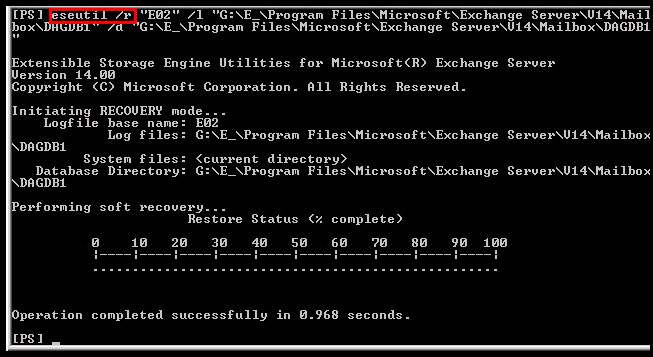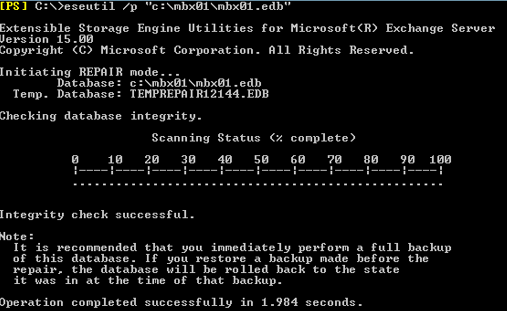How to Perform Exchange 2010 Database Recovery – Using Eseutil Commands?
Do you find difficulty to perform Exchange 2010 Database Recovery – using Eseutil commands? If yes, this article and know how users can easily recover their Exchange mailbox database.
The main responsibility of the Microsoft Exchange Server administrator is to maintain high availability when it comes to the messaging environment. They have to make sure that the server keeps running smoothly without any glitches. No matter how easy it may appear/seem but it is not a piece of cake to maintain the server.
There are time when users get unexpected technical issue, software-related problems, human error, etc… due to which it interrupts the working of the Exchange Server. Sometimes because of some issues like – corruption, dirty shutdown, Exchange Server crash, failed / unable to mount database, and much more. All this error or issue make the Exchange database inaccessible and then users is not able to access the EDB, mailboxes or its data items. Also, you will not able to receive or send the mails and there are chances that users may lose Exchange data.
That’s why it is important to perform Exchange database recovery and make it accessible for using so that they can access the mailboxes and able to do their work without any interruption.
Users can find the problem by using the Eseutil utility and its cmdlet which help users to find the cause that makes the mailbox database in an inconsistent state. So, let’s move towards the solution that allows users to perform EDB recovery.
Manual Technique for Exchange 2010 Database Recovery – Using Eseutil Commands
Users can use the in-built utility i.e. Eseutil provided by Microsoft that helps Exchange administrator to repair the inaccessible or corrupt Exchange database file. You can perform soft and hard repairs via using this tool.
You can use the Eseutil cmdlets to check the database state and integrity of lost and damaged data, repair, and perform defragmentation. Then, users can use the Isinteg cmdlet after eseutil to fix & test the condition.
Exchange admin or users use the Eseutil command to perform the Exchange database recovery when it gets damaged or corrupted. It works with the EDB file, Streaming Media File (.stm), Extensible Storage Engine (ESE), and log file.
Pre-requisites:
- Login as MS Exchange administrator
- Then, take the backup of existing mailbox database
- Use the Exchange Server to completely dismount the database
- After that, move the unnecessary file and folder
- Require ample amount of storage space (It should be double the size of mailbox database)
- Then, use the CHKDSK utility (Check Disk) to test the hard drive for bad sectors
Note: If your offline/dismounted EDB file is highly corrupted then to repair this mailbox database users should be technically sound and have hands-on experience. There are many Exchange users who are new to this environment and it is difficult for them to understand the manual solution to repair the database from corruption.
Pro Tip: So, to avoid the complexity and technicality of this method users can use the advance Exchange Server Recovery Tool which supports these Exchange database file (Public & Private) and used by technical and non-technical users to perform Exchange mailbox recovery from corruption in a hassle freeway. It provides Quick and Advance scan mode which recovers and repair minimal and highly corrupted offline/dismounted .edb file. After recovery, users can export the recovered mailboxes to Live Exchange Server 2016/2013/2010/2007/2003 mailboxes, Office 365, and multiple file formats.
Use Eseutil Commands to Perform Exchange 2010 Database Recovery
1. Execute the eseutil /mh cmdlet given below to check the database state i.e. Dirty or clean shutdown.
Syntax:
eseutil /mh “insert-file-path\DatabaseName.edb”
After executing the command if the mailbox database is in clean shutdown then move all the log files from the transaction log folder path & mount the stores.
2. If the state of the Exchange database is dirty then check the log file which is mentioned below as log required: 3-3 is available or now.

3. After that, ensure that the log file which is required is in a clean state. For that users can use the eseutil /ml command to check the health of the log file.
Syntax:
eseutil /ml “target_location_of_logfile\log prefix”
4. If the log files are healthy then users can perform the soft repair by using the eseutil /r cmdlet which is given below:
Syntax:
eseutil /r “log prefix” /l “location_of_log_files” /d “location_of_database”
Example:

5. If the cmdlet executes successfully then again check the state of the database via eseutil /mh command. If the database is in clean shutdown that mount the mailbox database and if the EDB is still in dirty state then users have to perform hard repair by using eseutil /p cmdlet.
Syntax:
eseutil /p “enter-databasefile-location\DatabaseName.edb”
Example:

When you run the following cmdlet given above then a warning dialogue box appear. If users want to proceed forward then click on the OK button.

6. After that, users have to perform defragmentation and rebuild indexes by using the command given below. It also removes the empty page in the EDB file and rebuilds its indices.
![]()
7. Then run the isinteg cmdlet mentioned below to fix the logical corruption & repair the mailbox database at the application level.
![]()
8. Then, when the Exchange database comes in a clean shutdown state. Select the recovered database from the MS Exchange directory.
Shortcoming of Manual Solution
- Requires in-depth knowledge, technical skills, and hands-on experience
- It is a prolonged, time-consuming method. Also, it needs a large amount of storage space to perform the recovery.
- There is a risk of data loss which is permanent and users cannot predict that how much data is lost.
Note: This is not a 100 % solution to perform database recovery because there are several factors that occurs different way in real-world environment. So, users have to be focus and act accordingly as the problem occurs. But if you have highly corrupted EDB file then use can use the automated wizard described in the above section which easily repair the offline/dismounted database in a simplified way without any hassle.
Bringing It All Together
In this write-up, we have provided detailed information on how to perform Exchange 2010 database recovery – using eseutil commands. Users can use the solution provided here and recover the Exchange database. In case, if your EDB file has minimal or major corruption then you can use the advanced solution mentioned here which easily repair the mailbox database in a hassle freeway without any hindrance. Rest, according to your preference you can select the solution and recover Exchange database.



